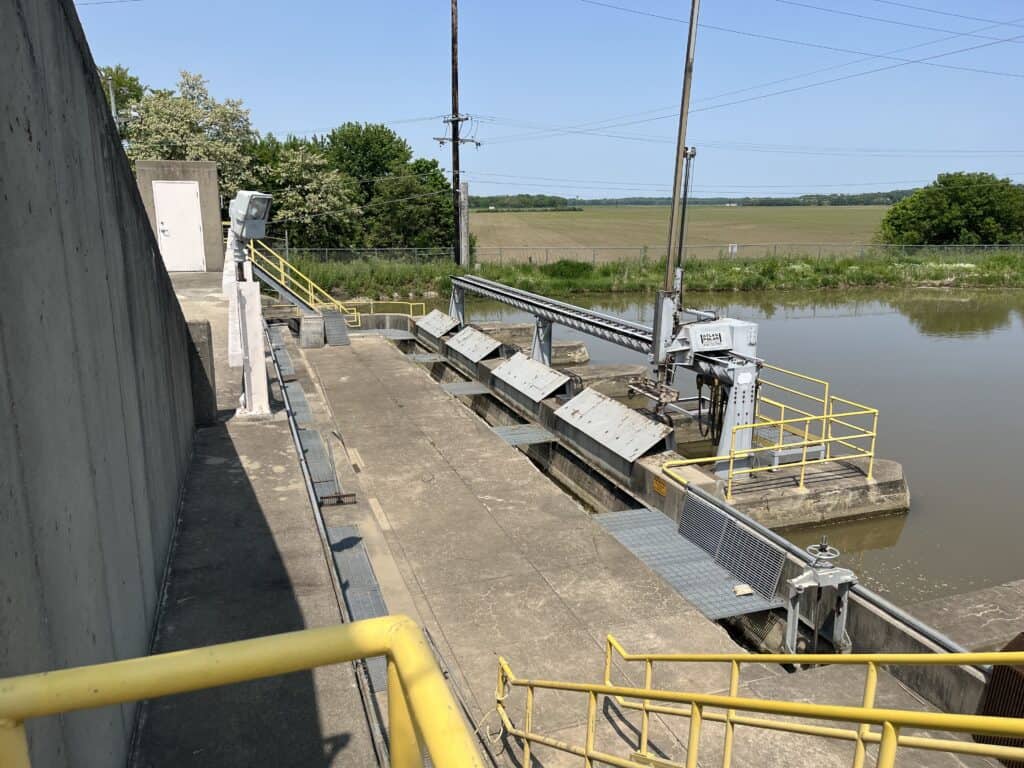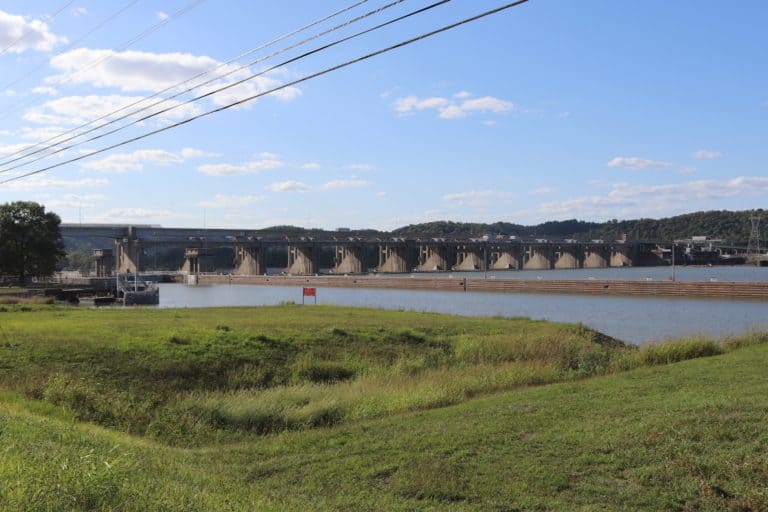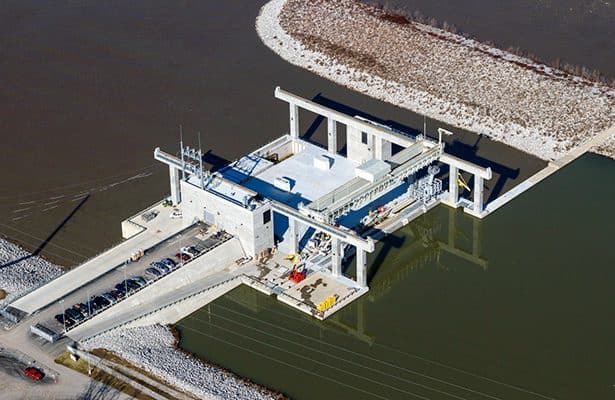Clean Currents 2023
Hydro Plant Tours, Offered by Host Utilities
Unique Opportunities to Learn, Network with other Attendees, and See Hydropower in Action!
Thanks to the Clean Currents’ host utilities, attendees can tour 3 hydro projects in the Cincinnati area.
Click on each project name to get more details for the tour of that project.
- Americana Tour at Hamilton Hydro – host: City of Hamilton, Ohio
- Markland Hydroelectric Plant and Locks and Dams – hosts: Duke Energy Corporation and U.S. Army Corps of Engineers
- Meldahl Hydroelectric Plant – hosts: City of Hamilton, Ohio, and American Municipal Power
To attend one or more of these tours, you’ll need to purchase a ticket ($50 per tour) when you register for Clean Currents.
Or, if you’ve already registered, you can add one or more tours to your existing registration.
Exploring Hydropower on the Ohio River
Americana Tour at Hamilton Hydro
Hosts: City of Hamilton, Ohio
Friday, October 13
8:30 am – 12:00 pm
Maximum Capacity: 50 people

If you are a history buff, love exploring the ingenuity of hydro, or work in small hydro, this tour is for you.
This tour presents a unique opportunity to experience the current and historical importance of hydropower to the City of Hamilton, Ohio (about 45 minutes from Cincinnati – travel time incorporated into tour start and end times).
The 2-MW Hamilton Hydroelectric Facility is located on the Ford Canal which is part of the Great Miami River Waterway. The facility has been owned by the City of Hamilton since 1963 and generates enough energy to supply more than 400 local homes annually.
In 1918, Henry Ford and Son Inc. purchased the Hamilton & Rossville Hydraulic Co. for approximately $200,000. The New York Times reported Ford’s plans to “spend millions of dollars developing the water power of the United States,” including the water-powered tractor plant that Ford Motor Co. would open in Hamilton in 1920. The plant was located along the newly constructed Ford Canal and electricity was supplied to the plant by hydroelectric power generated from the canal.
Ford and Son Co. owned the hydroelectric facility on the canal until Ford’s local plant was closed and sold to Bendix Aviation Corp. in 1951.
In 1963, the manufacturing plant was purchased by Ward Manufacturing Co., and the adjacent hydroelectric facility was acquired by the City of Hamilton to supplement the City’s electric generation assets.
On site, tour participants will be split into four groups in order to experience four “stations” covering a wide range of topics, such as:
- The story of Hamilton Hydraulic’s canal, constructed in the 1840s
- The Henry Ford connection, covering the famed entrepreneur’s fascination with hydroelectric power and its relationship to Hamilton’s hydropower history
- Native settlements and history, exploring archaeological digs and early cultures
- Current hydroelectric operations, which gives attendees a look inside the Hamilton Hydroelectric Plant – a 2-MW facility located on the Ohio River
After the tour concludes, participants will be served light refreshments and will be able to network, ask questions to subject matter experts, and, potentially, view artifacts from Hamilton’s past.
Markland Hydroelectric Plant and Locks and Dams
Hosts: Duke Energy Corporation and U.S. Army Corps of Engineers
Tuesday, October 10
1:00 pm – 5:30 pm
Maximum Capacity: 80 people (participation limited to U.S. citizens)
Due to security processing time, you may no longer sign up for the U.S. Army Corps of Engineers lock and dam side of the tour. You can still visit the Duke Energy hydroelectric facility.

Tour participants will travel by bus to the site, which is located on the Ohio River, only an hour from downtown Cincinnati.
The 1,395-foot-long and 150-foot-high concrete dam bridge and locks span the Ohio River and connect Gallatin County, Kentucky, and Switzerland County, Indiana. The navigation locks were completed in 1959 and the dam was completed in 1964. The U.S. Army Corps of Engineers Louisville District in the Great Lakes & Ohio River Division owns and operates the locks and dam.
The Markland hydroelectric facility was completed in 1967 by the Public Service Company of Indiana (now owned by Duke Energy) and has an installed capacity of 81 Mva. The facility harnesses energy produced from the flow of the river to produce electricity, within guidelines governed by the Corps of Engineers.
In 2022, Duke completed upgrades to the plant’s three hydroelectric turbines, generators, and other equipment. The upgrade took four and a half years to complete and cost approximately $152 million – well within the company’s projected cost estimate. With the completion of these equipment upgrades, Markland Hydroelectric Station can now generate up to 65 MW of renewable, carbon-free energy, depending on the flow of the river, which is enough to power 52,000 homes. The facility’s annual energy output has increased by 39 gigawatt hours (GWh) per year.
The upgrades included replacing turbine runner hubs and runner blades with a more efficient design. The company also replaced a number of other parts and components, including discharge rings, wicket gates, generator rewinds, generator excitation controls and relay protection, station controls, intake and draft tube gates, and the main power transformer. Crews also overhauled the high- and low-voltage electrical distribution systems at the station.
Meldahl Hydroelectric Plant
Hosts: City of Hamilton, Ohio, and American Municipal Power
Tuesday, October 10
8:00 am – 12:00 pm
Maximum Capacity: 100 people

Tour participants will experience the 105-MW run-of-the-river plant up close.
Named after Captain Anthony Meldahl, a renowned Ohio River riverboat captain in the 1800s, the Meldahl Hydroelectric Plant is located in Foster, Kentucky, an hour southeast of Cincinnati, at a U.S. Army Corps of Engineers lock and dam.
The facility, which reached full commercial operation in 2016, is the largest hydroelectric power plant on the Ohio River and has an annual output of 523.2 million kilowatt-hours, with the highest annual output occurring in 2021 with 639.4 million kilowatt-hours generated.
The site includes an intake approach channel, a reinforced concrete powerhouse, and a tailrace channel. The powerhouse contains three horizontal bulb-type turbine-generating units with a total rated capacity of 105 MW.
The tour features a look at the powerhouse, which sports a crane spanning 190 feet that can pick up 175 tons – the equivalent of a Boeing 747 jet.
The powerhouse is designed to be overtopped during flood events by as much as 25 feet of water.

Quick Links
Share


